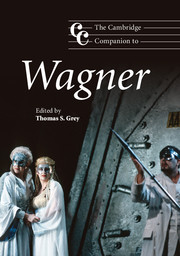Book contents
- Frontmatter
- PART I Biographical and historical contexts
- PART II Opera, music, drama
- PART III Ideas and ideology in the Gesamtkunstwerk
- PART IV After Wagner: influence and interpretation
- 13 “Wagnerism”: responses to Wagner in music and the arts
- 14 Wagner and the Third Reich: myths and realities
- 15 Wagner on stage: aesthetic, dramaturgical, and social considerations
- 16 Criticism and analysis: current perspectives
- Notes
- Select bibliography
- Index
13 - “Wagnerism”: responses to Wagner in music and the arts
from PART IV - After Wagner: influence and interpretation
Published online by Cambridge University Press: 28 September 2011
- Frontmatter
- PART I Biographical and historical contexts
- PART II Opera, music, drama
- PART III Ideas and ideology in the Gesamtkunstwerk
- PART IV After Wagner: influence and interpretation
- 13 “Wagnerism”: responses to Wagner in music and the arts
- 14 Wagner and the Third Reich: myths and realities
- 15 Wagner on stage: aesthetic, dramaturgical, and social considerations
- 16 Criticism and analysis: current perspectives
- Notes
- Select bibliography
- Index
Summary
Wagner's impact on Western culture can hardly be overestimated. When Howard Shore describes his use of leitmotifs in the Oscar-winning score for the blockbuster trilogy The Lord of the Rings (2001–03), for example, he reveals himself as but one recent musician in a long line of creative artists affected by Wagner the composer. Wagner's theories about musical theater can be felt even in contemporary discussions of Broadway musicals, such as Oklahoma! (1943) and Rent (1996). As for modern opera, Olivier Messiaen's Saint François d'Assise (1983), Luciano Berio's Un re in ascolto (1984), and Karlheinz Stockhausen's cycle Licht (1977–2004) are among the more recent responses to the challenges posed by Wagner almost 150 years ago. In fact, artists from all disciplines over the last century and a half have likewise relied on aesthetic concepts shaped prominently by Wagnerian ideas about the nature of art, whether Symbolist poets such as Charles Baudelaire, Paul Verlaine, and Stéphane Mallarmé avant-garde painters such as Wassily Kandinsky, Pablo Picasso, Joseph Beuys, and Anselm Kiefer; the sculptors Hans Arp and Auguste Rodin; or the architects of the Bauhaus. Media technology itself, when related to art, has drawn its aesthetic justification from Wagner's thoughts. And his political and social views influenced the Zionist Theodor Herzl as well as the anti-Semitic fascist Adolph Hitler, with repercussions still powerfully felt in concert life today – in Israel, above all, but worldwide as well.
- Type
- Chapter
- Information
- The Cambridge Companion to Wagner , pp. 219 - 234Publisher: Cambridge University PressPrint publication year: 2008

